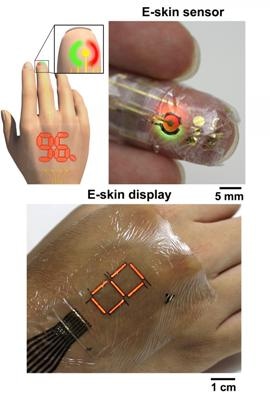Apr 18 2016
An ultraflexible, ultrathin and protective layer has been developed by researchers from the University of Tokyo. The researchers illustrated the use of this material by developing an air-stable, organic light-emitting diode (OLED) display.
 Top left: System outline of a blood oxygen level monitor. Top right: Red and green polymer light-emitting diodes (PLEDs) are directed to shine into the finger. Reflected light from inside the finger is caught by an ultraflexible organic photodetector. This reflected light provides a measure of blood oxygen and pulse rate. Bottom: The output of the sensor can be shown on a PLED display. Credit: Someya Laboratory
Top left: System outline of a blood oxygen level monitor. Top right: Red and green polymer light-emitting diodes (PLEDs) are directed to shine into the finger. Reflected light from inside the finger is caught by an ultraflexible organic photodetector. This reflected light provides a measure of blood oxygen and pulse rate. Bottom: The output of the sensor can be shown on a PLED display. Credit: Someya Laboratory
This technology can be used to develop electronic skin (e-skin) heart rate sensors for athletes, and e-skin displays of oxygen level in blood to mention a few.
Researchers from all over the world aim to incorporate electronic devices with the human body in order to restore or improve body function for various biomedical applications. Thin and flexible wearable electronics are needed to minimize the impact where they are get fixed to the body. Until now, most of the devices that have been built needed glass or plastic substrates with thicknesses in the millimeter-scale, and have limited flexibility. The reason is the lack of stability of the micrometer-scale thin flexible organic devices in air.
Professor Takao Someya and Dr. Tomoyuki Yokota at the University of Tokyo's Graduate School of Engineering have invented a protective film, which is of superior quality and measures less than 2 µm in thickness. This new film enables the development of high performance, ultraflexible, ultrathin wearable electronic displays and a wide range of other devices. The research team formed the protective film by interchanging layers of inorganic (silicon oxynitrite) and organic (parylene) material. The protective film increased the lifetime of the device from a few hours to several days by blocking the passage of water vapor and oxygen in the air. The team were also able to fix transparent indium tin oxide (ITO) electrodes to an ultrathin substrate without causing damage, successfully obtaining the e-skin display.
The team used ITO electrodes and the new protective layer to develop organic photodetectors and polymer light-emitting diodes (PLEDs). These two materials were thin enough to be fixed to the skin and also had adequate flexibility for bending and crumpling in response to the movement of the body. When compared to previously developed ultrathin PLEDs, the newly developed PLEDs were found to be six times more efficient and had a thickness of only 3 µm. This decreased power consumption and heat generation, allowing them to be directly fixed to the body for a variety of medical applications, including displays for pulse rate or blood oxygen concentration. The researchers also demonstrated a blood oxygen sensor by integrating green and red PLEDs into a photodetector.
The advent of mobile phones has changed the way we communicate. While these communication tools are getting smaller and smaller, they are still discrete devices that we have to carry with us. What would the world be like if we had displays that could adhere to our bodies and even show our emotions or level of stress or unease? In addition to not having to carry a device with us at all times, they might enhance the way we interact with those around us or add a whole new dimension to how we communicate.
Takao Someya, Professor, University of Tokyo